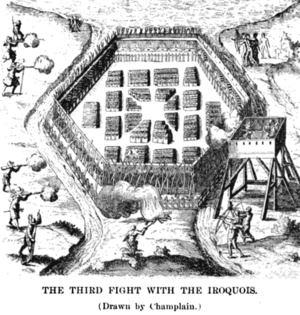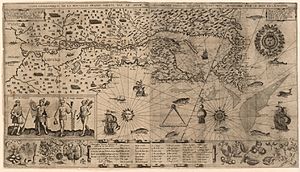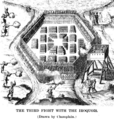Battle of Sorel facts for kids
Quick facts for kids Battle of Sorel |
|||||||
|---|---|---|---|---|---|---|---|
| Part of the Beaver Wars | |||||||
 |
|||||||
|
|||||||
| Belligerents | |||||||
Huron Algonquin Montagnais/Innu |
Iroquois | ||||||
| Commanders and leaders | |||||||
| Samuel de Champlain | Unknown | ||||||
| Strength | |||||||
| ~300 warriors 5 arquebusiers |
~100 warriors 1 fort |
||||||
| Casualties and losses | |||||||
| Between 15 and 20 killed 50 wounded |
100 killed 15 captured and later killed 1 fort captured |
||||||
The Battle of Sorel happened on June 19, 1610. It was a fight between Samuel de Champlain and his French allies, along with Native American groups like the Huron, Algonquin people, and Montagnais. They fought against the Mohawk people in a place called New France. Today, this area is known as Sorel-Tracy, Quebec.
Champlain's forces used special guns called arquebuses. They fought against the Mohawks and either killed or captured almost all of them. This battle was important because it stopped major fighting with the Mohawks for about twenty years. The Battle of Sorel was part of a bigger series of conflicts called the Beaver Wars. These wars involved the Iroquois confederation, especially the powerful Mohawks, fighting against Algonquian peoples near the Great Lakes. The Kingdom of France supported the Algonquian groups. The Beaver Wars lasted for almost a century, finally ending with the Great Peace of Montreal in 1701.
Why They Fought
Before 1603, Champlain had already made an agreement to fight against the Iroquois. The French had decided they would not sell firearms to the Iroquois. This was a business decision for Champlain. The Native groups in the north provided valuable furs to the French. The Iroquois, who lived in what is now New York State, were getting in the way of this important fur trade.
The French started to move their trading deeper into the land. This change became official when Quebec City was founded in 1608 by Samuel de Champlain. Quebec City was built on the St. Lawrence River. This settlement marked the start of French traders moving west. They went from their first permanent settlement at Tadoussac to the Great Lakes area. In the early 1600s, both the French and the Native groups made smart moves. They wanted to improve their own business and political power.
The first big battle in 1609 was started by Champlain himself. He went with a group of warriors down Lake Champlain. This battle caused a lot of distrust for 150 years. It made it hard for the French and Iroquois to ever form lasting friendships. Champlain wrote that he came "with no other intention than to make war." He and his Huron and Algonkin allies fought the Mohawk on the shores of Lake Champlain. Champlain even killed three Iroquois chiefs by himself with an arquebus. This happened even though the chiefs wore strong "arrowproof body armor."
What Happened Next
During the 1600s, the French created a military force in New France. This force included soldiers from the French army, French naval personnel, and Canadien volunteer groups. The French built many forts in North America. One of these was Fort Richelieu, built in 1641 near Sorel, at the mouth of the Richelieu River.
Charles Huault de Montmagny, the first Governor of New France, built the fort. He named it after Cardinal Richelieu, a very important minister to King Louis XIII. The Haudosaunee burned Fort Richelieu down in 1647. But it was rebuilt in 1665 by the Carignan-Salières Regiment. This rebuilding was led by Pierre de Saurel.
Images for kids



